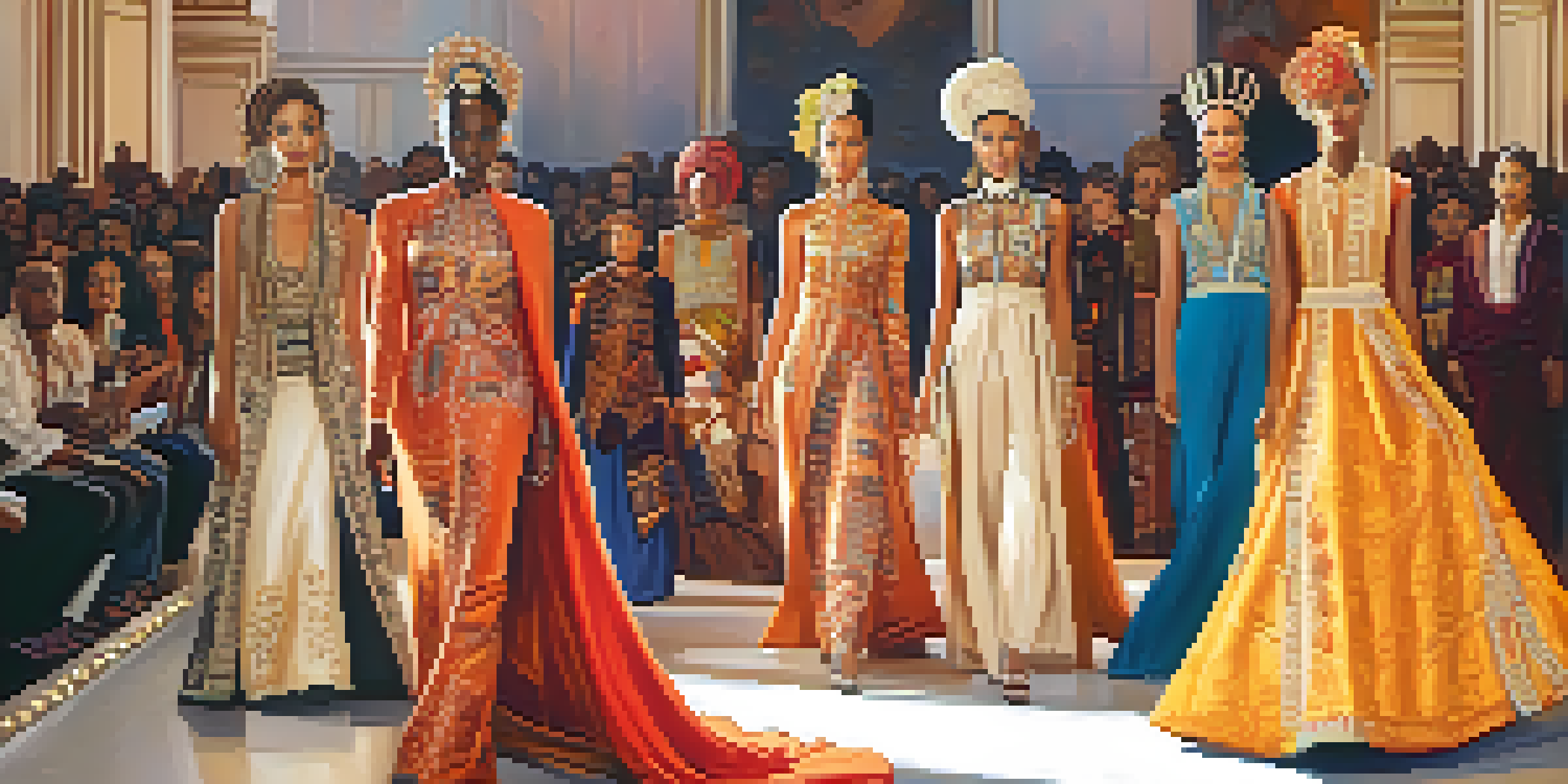Cultural Appropriation in Fashion: Social Movement Responses

Defining Cultural Appropriation in Fashion Contexts
Cultural appropriation in fashion refers to the adoption of elements from one culture by members of another, often without understanding or respecting its significance. This practice can lead to commodification, where traditional designs and symbols are used merely for aesthetic purposes in fashion. It's essential to differentiate between appreciation and appropriation, as the latter can overshadow and exploit the original cultural context.
Cultural appropriation is often a one-way street that strips meaning from marginalized cultures while elevating those who profit from it.
For instance, when designers use indigenous patterns or garments without acknowledgment, it raises questions of ethics and respect. This phenomenon has sparked debates about who gets to represent culture and how those representations can perpetuate stereotypes. Understanding this distinction is vital for both consumers and creators in the fashion industry.
Moreover, cultural appropriation often occurs in a power dynamic, where dominant cultures borrow from marginalized ones, leading to feelings of disenfranchisement. As a result, many voices within these cultures are calling for recognition, respect, and fair representation in fashion.
Historical Examples of Cultural Appropriation in Fashion
Historically, there have been numerous instances of cultural appropriation in fashion that have sparked outrage and discussions. One notable example is the use of Native American headdresses in runway shows, where their sacred significance is often overlooked. Such instances illustrate how fashion can misinterpret and trivialize cultural symbols, leading to widespread criticism.

Additionally, the popularization of the ‘geisha’ aesthetic in Western fashion raises questions about the portrayal of Asian cultures. When Western designers use elements of a culture without context, it can reinforce stereotypes rather than celebrate diversity. This highlights the importance of cultural sensitivity and awareness in the creation of fashion narratives.
Cultural Appropriation Explained
Cultural appropriation in fashion involves adopting elements from one culture by another, often without understanding their significance.
These historical examples remind us that fashion is not just about clothing; it’s also a reflection of societal values and attitudes. By examining past missteps, we can work toward a more respectful and inclusive approach to cultural influences in fashion.
Social Movements Challenging Cultural Appropriation
In recent years, social movements have emerged to challenge cultural appropriation within the fashion industry. Activists and advocates are raising awareness about the ethical implications of borrowing cultural elements. These movements aim to educate designers and consumers alike about the importance of cultural respect and ownership.
To borrow from one culture without the context of understanding and respect is to rob that culture of its significance.
For example, the #NotYourTaco campaign on social media highlighted issues surrounding the appropriation of Latinx culture in fashion. Through hashtags and visual storytelling, individuals shared their experiences and demanded accountability from brands. This grassroots approach exemplifies how social media can amplify voices that have historically been marginalized.
Moreover, these movements are pushing for changes in the industry, advocating for greater representation of diverse designers and models. By fostering an inclusive environment, the fashion world can better celebrate cultural richness rather than exploit it.
The Role of Designers in Addressing Appropriation
Designers play a crucial role in either perpetuating or combating cultural appropriation. By embracing cultural sensitivity and doing thorough research, they can create collections that honor rather than exploit cultural heritage. Collaborating with cultural insiders can lead to authentic representations that benefit both the creators and the communities involved.
For instance, some brands have begun to partner with artisans from specific cultures to produce collections that reflect genuine cultural narratives. This not only respects the original culture but also provides economic opportunities for those communities. Such practices can transform the way fashion engages with culture, promoting a model of shared success.
Social Movements Demand Change
Social movements are raising awareness about cultural appropriation and advocating for ethical practices and greater representation in fashion.
Ultimately, designers have the power to set trends and influence consumer perceptions. By prioritizing cultural respect in their work, they can lead the industry toward a more ethical and inclusive future.
Consumer Awareness and Responsibility in Fashion Choices
As consumers, we hold the power to influence the fashion industry through our choices. By being aware of the cultural implications behind fashion items, we can make more informed decisions about what we support. This awareness encourages brands to consider their practices and the messages they convey.
For example, when consumers question the use of culturally significant designs in mainstream fashion, it prompts brands to reassess their approaches. Engaging with fashion critically allows us to advocate for more ethical practices and promote brands that respect cultural heritage. It's a collective effort that can lead to meaningful change.
Moreover, supporting brands that prioritize cultural collaboration and representation can help shift the narrative in fashion. By amplifying voices that celebrate diversity, we can foster a more inclusive industry that honors cultural contributions rather than appropriating them.
The Impact of Social Media on Fashion and Culture
Social media has become a powerful tool for raising awareness about cultural appropriation in fashion. Platforms like Instagram and TikTok allow voices from diverse backgrounds to share their perspectives and challenge dominant narratives. This democratization of conversation enables a broader audience to engage with the topic actively.
Furthermore, social media campaigns can quickly mobilize support around issues of appropriation, leading to real-time accountability for brands. When consumers call out cultural insensitivity, it often leads to a ripple effect, prompting discussions in both mainstream media and within the fashion industry itself. This highlights the importance of consumer vigilance.
Designers' Role in Cultural Respect
Designers can combat cultural appropriation by conducting research and collaborating with cultural insiders to create authentic representations.
However, while social media can be a force for good, it's also essential to approach these discussions with nuance and empathy. Understanding the complexity of cultural exchange helps us navigate the conversation more effectively, promoting a more respectful dialogue about fashion and culture.
Looking Ahead: Future Directions in Fashion and Cultural Respect
As the fashion industry evolves, so too does the conversation around cultural appropriation. The growing awareness and advocacy for cultural respect are encouraging brands to rethink their strategies and practices. This shift toward inclusivity can lead to a more ethical fashion landscape that values diversity and cultural contributions.
Moving forward, it’s crucial for the industry to continue fostering dialogue and collaboration between cultures. By prioritizing education and understanding, designers can create work that reflects a genuine appreciation for the cultures they draw inspiration from. This not only enriches fashion but also promotes social responsibility.

In conclusion, the path ahead involves ongoing engagement with cultural sensitivity. By embracing this journey, the fashion industry has the potential to redefine its relationship with culture and pave the way for a more respectful and inclusive future.